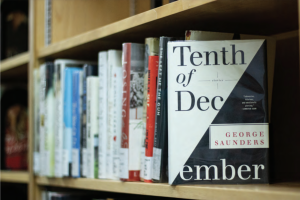Why you should read George Saunders
November 4, 2020
People tend to laugh much more frequently when interacting with others, which can pose a problem due to this whole global-pandemic-induced isolation thing. Less social interaction, less laughter, less joy. Plus an election. Christ, what a bleak existence.
Fortunately, it’s not all gloom and doom. Good things do exist. There are puppies and sunrises and our beloved sports back on TV. And there’s the writing of George Saunders.
George Saunders is primarily known as a writer of short stories, although he’s published brilliant essays and longer-form writings as well. Here I’ll focus on his short fiction.
If you browse a catalogue of the great writers of history, only a few authors have a style of writing so outstanding it’s immediately recognizable. Hemingway’s minimal, objective narrations, or Burgess’ unique, jarring language can both be recognized after just a couple sentences. George Saunders’ writing is of the same unique caliber.

His writing is very funny in a somewhat dry, somewhat absurd but always wonky kind of way. It has a quality you would expect if a set of technical instructions fell into the hands of a satirist before being slipped to a printer.
Saunders’ writing is in the first-person limited perspective, and he employs a certain degree of the stream of consciousness. However, this is not some new or highly experimental kind of writing; this is not “Finnegan’s Wake.” Saunders’ writing reads exceptionally fluidly, taking you through the narrators’ thoughts, not in a jarring, haphazard fashion, but with the swift cadence of words spoken aloud.
His writing is quirky, full of made-up food products like “Stars-n-flags” and “SmallCows” and the use of invented Proper Nouns. Saunders excels at creating strange metaphors and comparisons, and the tight economy of language he uses in his stories only makes each sentence hit harder. The short story format works perfectly for Saunders because his writing whisks the reader along, taking them on a wild ride, before spitting them out at the other end.
A second noteworthy feature of Saunders’ writing is how profoundly empathetic it is. Saunders humanizes each antagonist and reveals the darkness in each protagonist. He draws you in and makes you feel what they characters of the book are feeling: fear, uncertainty, loneliness — and boundless joy.
His characters are complex on a deeply human level. They are faced with hard decisions. Not necessarily big decisions, but hard ones; decisions that make them afraid.
Something beautiful in Saunders’ stories is this fear; this all-too-human fear that grips us when we’re presented with a situation in which we can back down or stand up. His stories are portraits of how sometimes the easiest things are the hardest to do — the scariest — and how you can be gripped with terror even in the moment you do the right thing.
Saunders’ characters use this fear as a compass; it guides their actions in the right direction. Saunders’ short stories are a welcome antithesis to Philip K. Dick’s, where characters often fail in the decisive moments. Saunders often win, but it’s not glorious; they’re victories with protagonists whimpering the whole way, eyes wide in terror, only to emerge safe on the other side.
George Saunders’ writing will make you laugh, and then cry, and then laugh again; the gold standard of emotional responses to literature.













